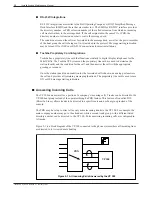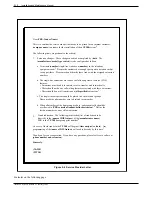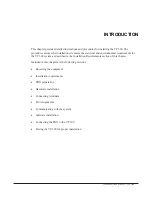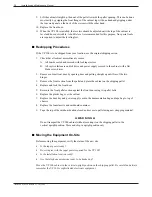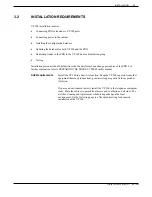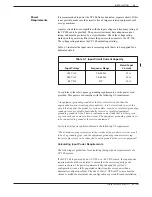
Record the pilot number for each hunt group. Depending on the PBX type, the pilot number may
be either:
•
A phantom number with no actual extension appearance
•
The first extension of the hunt group
Make the hunt group number easy to dial and easy to remember, since employees use this number
to access the VP 300. Some phone systems permit single-digit access to hunt groups. For
example, employees need only dial
5
to reach the VP 300.
6.
Determine how to set up a fail-safe answering position based upon features available for the PBX
type. This may be either programmed in the PBX as an overflow situation or by call forwarding
the hunt group pilot or member extensions. If none of these are permitted, refer to item 5 (above).
■
Called Extensions
Because the VP 300 provides call coverage for busy stations, any type of call waiting
1
feature
provided by the PBX is not required. Remove this feature from the PBX configuration for extensions
called through the VP 300. PBX call waiting can mislead the second caller who hears that the
extension doesn’t answer instead of hearing the true busy status.
Remove any system call forwarding for call coverage (to a message center, etc.).
■
Trunks
Possible changes to the PBX trunk programming include redirecting trunks to the VP 300 and assuring
any trunking changes do not affect the selection of trunks for outgoing calls. No changes need to be
made to the DID trunking or programming in the PBX.
■
Trunk Redirection
Trunks are directed to the VP 300 via a PBX feature. Many PBX manufacturers call this feature DIL,
Direct In Lines, or DIT, Direct In Trunks. If the phone system does not provide a DIL-type feature,
refer to Implementing the VP 300 on PBXs Without DIL Feature in this chapter. If you are trying to
determine the appropriate feature, first look for DIL, the most commonly used name.
If you can talk with someone familiar with the phone system, describe the feature (i.e., “ability to
direct a trunk or group of trunks to a specific extension or hunt group rather than being directed to an
attendant console for answer”). They should be able to supply the name of the feature for that phone
system.
1.
When a busy station receives a second call, notification of the second call is given by a tone that indicates a call is
waiting. The busy station may ignore the tone or place the first call on hold to answer the second. The notification
tone is only heard by the called person and the caller hears ringing instead of a busy tone.
Toshiba VP Systems Release 6.1 February, 1993
2-8
Installation and Maintenance Manual
Содержание VP 300
Страница 2: ......
Страница 10: ......
Страница 14: ......
Страница 19: ...Quick Reference Guide Hardware Toshiba VP 300 System Specifications Toshiba VP Systems Release 7 1 July 1994 ...
Страница 20: ...Toshiba VP Systems Release 7 1 July 1994 ...
Страница 52: ...Toshiba VP Systems Release 6 1 February 1993 2 14 Installation and Maintenance Manual ...
Страница 56: ...Toshiba VP Systems Release 7 1 July 1994 ...
Страница 146: ......
Страница 312: ...Toshiba VP Systems Release 7 1 July 1994 ...
Страница 314: ......
Страница 444: ......
Страница 496: ......
Страница 542: ......
Страница 598: ...Toshiba VP Systems Release 6 1 February 1993 ...
Страница 600: ...Toshiba VP Systems Release 6 1 February 1993 ...









